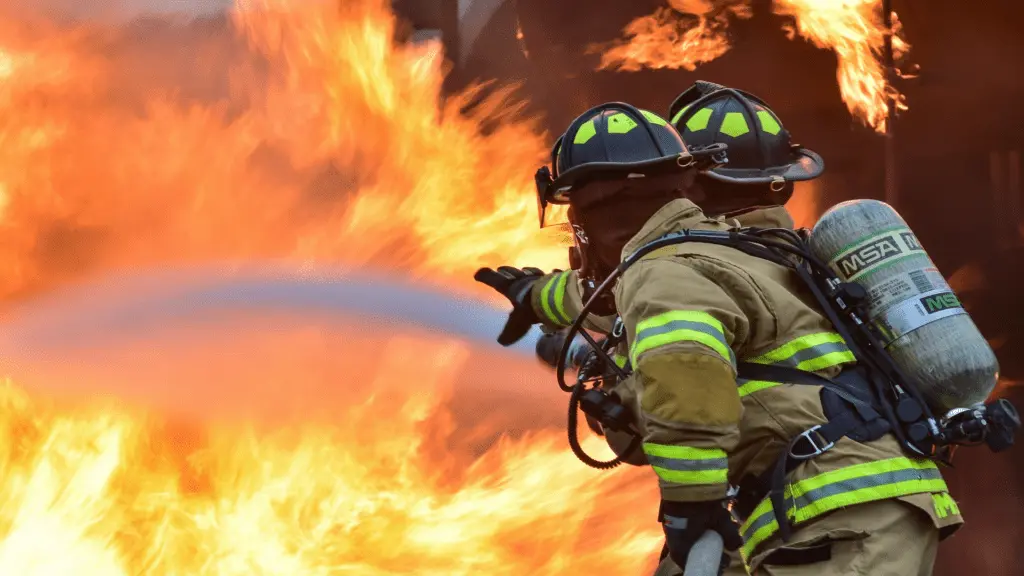
Wildfires are not only growing more common, but more intense. Scientists attribute the outbreak to drier, hotter conditions brought on by global warming. A warmer lower atmosphere sucks additional moisture out of plants, dead vegetation, and the soil, creating tinder-dry conditions. The trend also stems from the fact that more and more humans are living near forested areas, and humans trigger most forest fires.
When the Diamond Creek Wildfire blazed through Mazama Valley in 2017, it blazed over more than 100,000 acres of land. Colin Sands and his family had moved into a new home in the area less than a year before. Thanks to their “fire-proof” home, however, the Sands family didn’t suffer the destruction that so many others did.
Sands and his home’s architect, Dan Nelson, of Northwest Designs, had designed and built the 2,400-square-foot house according to voluntary fire safety guidelines published by the National Fire Protection Agency. They provide guidance on everything from the best place to site your home, to the best building materials to use, to critical landscaping techniques. Many of the recommendations are contained in the Wildland Urban Interface Code (WUIC) published by the International Code Council and are picked up in a few select local building codes.
Some of the preemptive measures the Sands family took were:
Don’t Build on a Hill
The last place you want to build a home in a wildfire-prone area is on the top of a hill, especially if it’s in the path of prevailing winds; they increase the oxygen that fuels fire. Fire burns faster uphill because flames can easily reach more unburnt fuel in front of the fire. Plus, the radiant heat from a fire pre-heats fuel in front of the fire, making the fuel even more flammable. The Sands home was built on a level site, 2.5 acres of gently rolling meadow.
Use Wood Sparingly
The architecture of the Sands home and detached garage references the old metal barns and mining structures that dotted the valley a century before. Nelson framed the home with steel rather than wood, leaving rugged steel posts exposed for good measure. He cloaked the house with fire-rated metal roofing and non-combustible corrugated metal siding.
Where wood was used, it would be difficult for fire to reach. Concrete, for instance, sits at the base, where tight-knot cedar boards were used on the exterior. Metal roofing covers the exposed plywood sheathing and rafters in the roof. Some versions of the WUIC require fire-resistant gypsum behind exposed exterior wood, or wood that’s so thick it would take an hour for fire to burn through. The idea is to give fire fighters an hour to respond.
“Ninety-five percent of the exterior is metal, concrete, or glass,” says Sands. “And we can soak the entire house with irrigation.”
No Crawl Space or Vented Attic
Homes built on crawl spaces are particularly vulnerable to spreading fire, especially if they have an under carriage of exposed wood. The Sands home rests on a slab on grade. A vented attic is another place that fire commonly strikes. Flying embers will enter a house through unprotected attic vents. Nelson insulated the attic so that it wouldn’t have to be vented, and he used double-paned tempered glass windows. They resist heat build-up and are less likely to pop under the pressure of fire.
Consider What’s Around the House
A wildfire attack reaches peak temperatures within seconds. The brief attack may be followed by spot fires that start on and within your home by wind-driven flames and embers. That’s why you must pay close attention not only to what your house is made of, but what you put around it. Nelson elevated the deck and built it with non-combustible materials. Patio furniture is metal, not wood, and firewood is kept far from the house.
Consider Landscaping and Vegetation
The fire-safe guidelines provide extensive landscaping guidance. The basic idea is not to plant anything that might catch fire within five feet of the house, called the “ignition zone.” For that reason, most of the landscape around the Sands house is “a three to four-foot sea of rocks.” Sprinklers in the yard allow it to be soaked if fire is near.
In a second zone five to 30 feet from the house, hardscape paths create a four-foot buffer between clusters of vegetation. (NFPA recommends that trees with a mature canopy reach no closer than 10 feet to the edge of the house.) Rockeries and gabion walls also block the path of fire. The goal of the third zone, 30 to 100 feet from the house, is to keep fires smaller and closer to the ground. “In addition, the perimeter of the landscape is flanked on all sides by 100 feet of native grasses in the event a back burn is needed for further protection,” says Sands.
Don’t Stop at the Exterior
The interior scheme limits combustible material as well. Most floors in the three-bedroom, 2.5-bathroom house are concrete. Another sprinkler system protects the interiors, too. It’s cheaper to build sprinklers into a home under construction than add them as a retrofit later. Metal accents abound inside the house. Sands worked with a local welder to design signature furniture – A TV stand, wine rack, and nightstand — that mix steel and mostly cedar.
Nelson’s goal was to not only design a fire-safe home, but an affordable one. By paying close attention to materials used and how they were used, the Sands were able to build the house for $300 a square foot. Other homes in the very popular second-home region run as high as $700 per square foot. The fire precautions also produced an insurance discount.
Perform Fire-Safety Maintenance
Simply designing a home to resist fire isn’t enough. The Sands family must diligently perform maintenance around the house and yard to make the home safe from embers and radiant heat. The fire-wise guidelines recommend the following:
- Clean roofs and gutters of dead leaves, debris and pine needles that could catch embers
- Replace or repair any loose or missing shingles or roof tiles to prevent ember penetration
- Clean debris from exterior attic vents and install 1/8-inch metal mesh screening to reduce embers
- Repair or replace damaged or loose window screens and any broken windows
- Screen or box-in areas below patios and decks with wire mesh to prevent debris and combustible material from accumulating
- Move any flammable material away from wall exteriors: mulch, flammable plants, leaves and needles, firewood piles – anything that can burn
- Remove anything stored underneath decks or porches
As the Diamond Creek wildfire blazed around them, the Sands family hunkered down in their new custom house knowing they’d done everything they could to build a fire-resistant home.
“We endured the raining ash for weeks,” says Sands. “We watched while neighbors removed trees and grass around their house. We sat knowing we were safe and clear. It was scary, but gratifying.”

Boyce Thompson is the author of three books on residential design and construction. His first book, The New New Home, published by The Taunton Press, was named book of the year by the National Association of Real Estate Editors. Anatomy of a Great Home (Schiffer Publishing 2018) features the work of three dozen of the country’s leading architects. The book identifies the common elements of great residential architecture, breaking them down into terms anyone can appreciate. Designing for Disaster, to be published by Schiffer in 2019, identifies best practices for resilient home design.
In 2008, Thompson was given the Crain Award by American Business Media for lifetime achievement in business media. In 2010, he was inducted into the Editorial Hall of Fame by min magazine, a magazine for publication professionals. Thompson holds a BA in English from Northwestern University and a master’s degree in journalism from the University of Missouri. He lives in Bethesda, Maryland.
 Is Tiny House Retirement Right for You?
Is Tiny House Retirement Right for You?